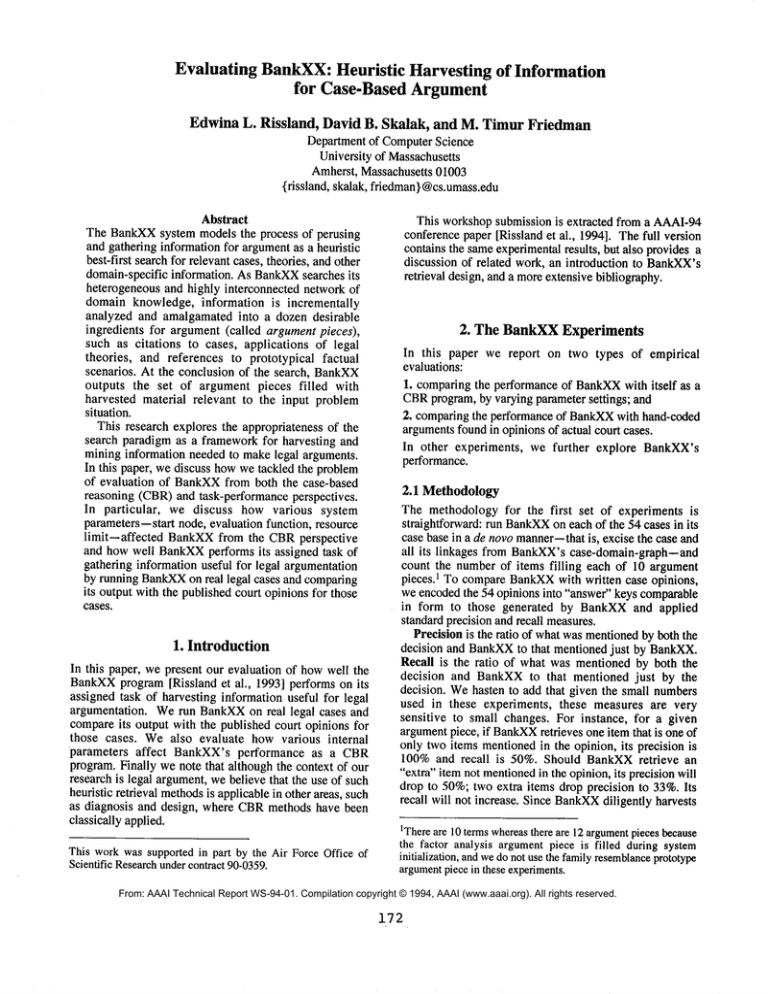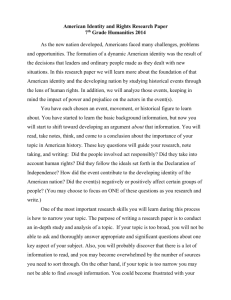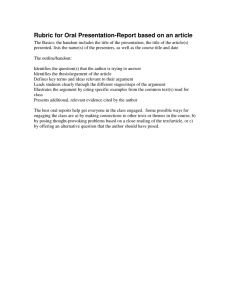
Evaluating BankXX:Heuristic Harvesting of Information
for Case-Based Argument
EdwinaL. Rissland, DavidB. Skalak, and M. TimurFriedman
Department of Computer Science
University of Massachusetts
Amherst, Massachusetts 01003
{rissland, skalak, friedman}@cs.umass.edu
Abstract
The BankXXsystem models the process of perusing
and gathering information for argumentas a heuristic
best-first search for relevant cases, theories, and other
domain-specific information. As BankXX
searches its
heterogeneous and highly interconnected network of
domain knowledge, information is incrementally
analyzed and amalgamated into a dozen desirable
ingredients for argument (called argument pieces),
such as citations to cases, applications of legal
theories, and references to prototypical factual
scenarios. At the conclusion of the search, BankXX
outputs the set of argument pieces filled with
harvested material relevant to the input problem
situation.
This research explores the appropriateness of the
search paradigm as a framework for harvesting and
mining information needed to make legal arguments.
In this paper, we discuss howwe tackled the problem
of evaluation of BankXXfrom both the case-based
reasoning (CBR)and task-performance perspectives.
In particular,
we discuss how various system
parameters--start node, evaluation function, resource
limit--affected
BankXXfrom the CBRperspective
and how well BankXXperforms its assigned task of
gathering information useful for legal argumentation
by running BankXX
on real legal cases and comparing
its output with the published court opinions for those
cases.
1. Introduction
In this paper, we present our evaluation of howwell the
BankXXprogram [Rissland et al., 1993] performs on its
assigned task of harvesting information useful for legal
argumentation. Werun BankXXon real legal cases and
compareits output with the published court opinions for
those cases. We also evaluate how various internal
parameters affect BankXX’s performance as a CBR
program. Finally we note that although the context of our
research is legal argument, we believe that the use of such
heuristic retrieval methodsis applicable in other areas, such
as diagnosis and design, where CBRmethods have been
classically applied.
This workwas supported in part by the Air Force Office of
Scientific Researchundercontract 90-0359.
This workshop submission is extracted from a AAAI-94
conference paper [Rissland et al., 1994]. The full version
contains the sameexperimentalresults, but also provides a
discussion of related work, an introduction to BankXX’s
retrieval design, and a moreextensive bibliography.
2. The BankXX
Experiments
In this paper we report on two types of empirical
evaluations:
1. comparingthe performance of BankXXwith itself as a
CBRprogram, by varying parameter settings; and
2. comparing the performance of BankXXwith hand-coded
argumentsfound in opinions of actual court cases.
In other experiments, we further explore BankXX’s
performance.
2.1 Methodology
The methodology for the first set of experiments is
straightforward: run BankXX
on each of the 54 cases in its
case base in a de novomanner--that is, excise the case and
all its linkages from BankXX’scase-domain-graph--and
count the number of items filling each of 10 argument
pieces. 1 To compare BankXXwith written case opinions,
we encoded the 54 opinions into "answer" keys comparable
in form to those generated by BankXXand applied
standard precision and recall measures.
Precision is the ratio of what was mentionedby both the
decision and BankXXto that mentioned just by BankXX.
Recall is the ratio of what was mentioned by both the
decision and BankXXto that mentioned just by the
decision. Wehasten to add that given the small numbers
used in these experiments, these measures are very
sensitive to small changes. For instance, for a given
argumentpiece, if BankXX
retrieves one item that is one of
only two items mentionedin the opinion, its precision is
100% and recall is 50%. Should BankXXretrieve an
"extra" item not mentionedin the opinion, its precision will
drop to 50%; two extra items drop precision to 33%. Its
recall will not increase. Since BankXX
diligently harvests
1Thereare 10 terms whereasthere are 12 argumentpieces because
the factor analysis argumentpiece is filled during system
initialization, andwedo not use the familyresemblance
prototype
argumentpiece in these experiments.
From: AAAI Technical Report WS-94-01. Compilation copyright © 1994, AAAI (www.aaai.org). All rights reserved.
172
as muchinformation as it can, it is likely to mentionmore
items than the opinion and be penalized for it in precision
and not get credit for it in recall. Thus, one should be
careful in reading too muchinto these traditional metrics.
Nonetheless, given their widespread use, we do use them
here.
Creating the "answers" needed for precision-recall
comparisons was done by reading the court’s opinion and
encodingeach case and theory actually cited in the opinion.
One problem inherent in encoding written opinions with
the set of original argument pieces is how to identify
elements fitting each argument piece, since some have
technical BankXX
meanings (e.g., best case) or make fine
distinctions hard for humanreaders to discern (e.g.,
applicable versus nearly applicable legal theory, best versus
merely supporting cases). In BankXX,these distinctions
are made in a principled
way with computational
definitions. To compensate for such difficulties,
the
argumentpieces were aggregated into four larger-grained
argumentpieces that were easy to apply.2 These were then
used in hand-coding court opinions and as the basis of
BankXXversus actual court performance comparisons.
The four simplified argument pieces are: (1) CitedSupporting-Cases, 3 (2) Cited-Contrary-Cases, 4 (3)
Cited-Leading-Cases, and (4) 5Cited-Legal-Theories.
With these aggregated argument pieces, hand-coding
was straightforward
and involved little
subjective
judgment.Anycase cited in the opinion is listed as a citedsupporting case or a cited-contrary case depending on
howits outcomecompareswith decision in the opinion.6 If
a cited case is also one that is frequently cited by written
opinions in general, 7 it is also listed as a cited-leading
case. If an opinionexplicitly articulates a theory of its own,
reiterates or applies the theory of another case, or appeals
to a general domaintheory (e.g., a "totality of the facts and
circumstances" theory of good faith), then that theory is
encodedas a cited-legal-theory.
2Note five argumentpieces are not used in the aggregated
argument pieces: supporting-citations, factor-analysis,
overlapping-cases, factual-prototype-category, familyresemblance
-prototype.
3Definedfor BankXX
as the union of supporting-casesand bestsupporting-cases.
4Definedfor BankXX
as the union of contrary-cases and bestcontrary-cases.
5Definedfor BankXX
as the union of applicable-legal-theories
and nearly-applicable-legal-theories.
6Complications,such as the fact that a sameside case mayhave
beencited (with a so-called Butsee citation signal) in order to
differ withits rationalewhilestill agreeingwithits outcome,are
overlooked.
7A frequency analysis was done on a corpus of cases of
approximately800 cases gathered with a WestLaw
retrieval. We
then checkedthe citation frequencyof each of BankXX’s
cases in
this larger corpus.Thefive mostfrequentlycited cases wereused
to definecited-leading-casecategoryappliedto written opinions.
Bycontrast, for BankXX
leading-casesis definedwithrespect to
frequencyof citation within BankXX’s
owncorpus.
173
Output from these BankXX-court comparison runs can
be viewed in various ways. Figure 1 displays graphically
the finest-grained analysis. It showsresults for retrieval of
objects for the aggregated cited-leading-cases argument
piece for each of the 54 cases. Each bar compares
performance of BankXXwith the court opinion on one
case.
above
theaxis:cases
retrieved
byBankXX,
of which:
notmentioned
in theopinion
6- mentioned
in theopinion
n
:J~HIiHIII:~
i~~~iii!;i~
4................................................Illl~
::::::::::
~l
~~iiiii~:~
~ii~;iii:F:~
~iiiiii~iii~
ii~
theaxis:cases
mentioned
in thewrittenopinion,
6- below
butnotretrieved
byBankXX
Figureh Comparison
of retrieved cited-leading-casesusing the
argumentpiece evaluationfunction. Performance
on each of the
cases, in orderfromhighestto lowestprecision.
The vertical axis indicates the numberof items retrieved.
Everything above the zero represents items retrieved by
BankXXwith the black part of a bar representing those
retrieved by BankXX
and mentioned in the written opinion
and the lightly shaded part of the bar representing items
retrieved by BankXXthat were not mentioned in the
opinion. The darkly shaded part of the bar extending below
zero represents items mentioned in the opinion that were
not retrieved by BankXX.Graphically, precision is the
proportion of black out of the total bar above the zero;
recall is the proportion of black out of the combinedblack
and darkly shadedparts of the bar.
In summary,we ran BankXX
on each of the 54 cases in
its case base in de novofashion with each of two evaluation
functions, and comparedretrieval on each argumentpiece:
sapproximately1500 data points,
2.2 BankXX as a CBR program
This section describes three experiments we performed to
answer questions about BankXX
as a case-based retrieval
system:
1. Howimportant is the initial query in determining the
eventual outcomeof retrieval?
2. Howmuch knowledgemust the case retrieval function
havein order to be effective?
3. Whencan search terminate and the retrieval result be
satisfactory?
As a baseline, BankXX
was run with the Estus case, 695
F.2d. 311 (8th Cir. 1982), as start node, the argumentpiece
evaluation function, and search limited to closing 30 nodes.
Weaddressed the three questions above in search terms by
examiningthe effects of:
8GivenI0 argumentpieces used in the general CBR
experiments
and 4 in the BankXX-Court
comparisons,there are (2xI0 + 2x4)
54 data points.
1. varyingthe start node,
2. changing the evaluation function, and
3. trying different limits on the numberof nodes that could
be closed.
supporting
cases
supporting
bestcases
contrarycases
contrary
bestcases
citations
overlapping
cases
li.i...
applicable
theories
m
nearlyapplicable
theories
m
m
factual
prototype
story
m m m i
m m m m i
I
m
n
a
m n
im m i
i
n m
m 11 m
m
i m
mi
0I m
0 1 2 3 4 5 6 7 8 9 10 0 1 2 3 4 5 6 7 8 9 10 0 2 3 4 5 6 7 8 9 10
startnode
evaluationfunction
numberof nodesclosed
¯ random
¯ nodetype
¯ 10 nodes
Im Estus
Ill argument
piece
m30 nodes
~ moston-point
~ 60 nodes
Figure2: Average
number
of objectsfilling eachargument
pieceas the start nodeis varied(left),
the evaluationfunctionis varied(middle),andthe number
of nodesclosedis varied(right).
Weran BankXX
de novo on all 54 cases in the case base
most on-point case is another starting point likely to be
to obtain averages for the numberof objects filling each
relevant.
9argument piece.
The results showedthat the choice of start node, whichis
2.2.1 Initial Query Formulation. Using the argument
the
initial queryto the case base, madelittle difference to
piece evaluation function and stopping search after closing
retrieval.
As the left hand side of Figure 2 shows, the
30 nodes, three different nodes were used as start nodes: a
average number of objects found for each argument piece
randomcase, the Estus case, and a most on-point case. The
is about the same for each of the three start nodes. We
randomcase provides a base line. Estus is well knownin
examinedsearch paths through the case-domain graph to
this area of bankruptcy law--almost any research materials
understand why. It turns out that no matter where search
consulted by an attorney will soon lead to it--and therefore
starts in this case-domaingraph of 150nodes, it soon leads
it maybe considereda realistic and useful starting point. A
to a highly interconnected region which contains many
useful cases and theories. For exampleEstus and Flygare
9N.B., numbersof nodesclosed, opened,and filling an argument
(another well knowncase) and the theories promulgated
piece are not the same.In general, manymorenodesare opened
these cases are part of this area of the graph. Informally
than closed, and the total numberof items filling the set of
speaking, it doesn’t matter where search starts because in
argumentpieces exceedsthe numberof closed nodes(see Figure
this domainall roads lead to Estus.
2).
Weconclude that in browsinga case base where there is
a sense of location and a sufficiently rich indexingfabric,
174
the initial probe to case-memory may not matter in a
multiple-probesituation.
2.2.2 Case Retrieval Function. Next, we compared the
effects of varying the evaluation function while keeping the
30 closed node limit and alwaysstarting at the Estus node.
The node-type evaluation function finds more contrary
cases and same side cases, but does so at the expense of
failing to fill other argument pieces. See the middle of
Figure 2. The node-type function uses only the type for
each node and does not limit the number of objects
retrieved for any argumentpiece. Considering its lack of
knowledge,it does surprisingly well.
To understand how a knowledge-poor function can
producesatisfactory results, one can consider search as just
the first of a two-stage retrieval process for filling the
argument pieces. The second stage applies the argument
piece predicates to the retrieved objects to determineif they
fulfill the requirementsof the argumentpiece.
Weconclude that in a two-phase retrieval, a knowledgepoor function to generate candidates in the first phase may
be sufficient, as long as the performance criteria in the
second phase are sufficiently rich. The efficacy of the
classic generate-and-test or "many-are-called/few-arechosen" (MAC/FAC)
approach has been observed in other
research as well [Gentner & Forbus, 1991].
2.2.3 Termination of Search of Case Memory.There is
no objective standard for whenone has completed research
or completed an argument. Thus BankXX has two
termination parameters that may be set by the user:
limiting the time ("billable seconds") used and the number
of nodes closed. In these experiments BankXX
was set to
terminate after it had closed 10, 30, and 60 nodes.
With the argument piece evaluation function and Estus
as the start node, 10 nodes was too few to fill up manyof
the argumentpieces. As a rough guide, 30 nodes seemedan
appropriate compromise between more exhaustive search
and too scanty an examination of the domain-graph.
Incremental benefits of more search decreased after about
30 nodes. See the right hand side of Figure 2.
From the CBRperspective,
we conclude that the
decreased marginal utility of finding more cases causes
there to be a point at which additional search of the case
base is not effective. This conclusion echoes the results of
Veloso and Carbonell [1991] as to the optimal amount of
time to search a case base in a hybrid planner.
2.3 BankXX as an Argument Program
Using standard precision and recall measures, we compared
the performanceof BankXX
with written judicial opinions.
All 54 cases were run de novo with Estus as start node and
a limit of 30 closed nodes. Results were averaged over the
54 cases.
2.3.1 Precision/Recall Performanceand the Evaluation
Functions. Wewere somewhat surprised to find that in
general the knowledge-poornode-level evaluation function
usually exhibited higher recall and precision than the
175
knowledge-richerargumentpiece function. For instance, all
the average recall values for the node-type function lie
above the corresponding values for the argument piece
function. Averaged over the four simplified argument
pieces, the node-typeevaluation function gave higher recall
(0.55), than the argumentpiece evaluation function (0.44).
Weconclude that BankXX’soverall recall performance
seems to dependmore on the choice of evaluation function
than the choice of argument piece. The node-type
evaluation function maygive higher recall simply because
it retrieves more items than the argumentpiece function.
See the middle of Figure 2. The argumentpiece evaluation
function is moreselective but pays a price for that in recall.
recall
1.0_
0.9_
leading
cases
0.8-0.7--
theories
0.6 _
~k
contrary
cases
0.5-[]
u
.~’~
~r~
0.3 _
0.2 --
, argument
piece
same
sidecases
0.1_
0.0 +
0.0
I
0.1
I
0.2
I
0.3
I
0.4
I
0.5
I
0.6
I
0.7
I
0.8
I
0.9
I
1.0
precision
Figure3: Average
precisionandrecall (overall 54cases) for the
four aggregatedargumentpieces.
On the other hand, there seems not to be muchdifference
in overall precision performance between the two
evaluation functions. Each argument piece performs at
about the same precision for each function. As we did in
Section 2.2.2, we ascribe this to BankXX’stwo-stage
approach: the lack of precision inherent in the node-type
function is ameliorated by the precise filling of the
argumentpieces. Finally, we note that we did not observe
the classical trade-offs betweenprecision and recall. This
might be because BankXXis not be functioning at a
frontier where such phenomenaoccur or we need to vary
other parameters to see them. In these studies, we only
varied two, the evaluation function and the argumentpiece.
2.3.2 Recall/Precision
and Argument Pieces. We
observeddifferences in retrieval precision for the different
argument pieces (see Figure 3). For both evaluation
functions, highest precision was found for cited-leadingeases (0.46), followed by cited-contrary-eases, citedsupporting-eases, then cited-legal-theories (0.21). The
results for recall were similar for the argument piece
function. For the node-type function there was a flattening
of performance differences amongrecall for the three
argumentpieces involving cases; all three did well.
Weinterpret the better precision on cited-leading.cases
as follows. Since the same small group of leading cases are
cited repeatedly in the opinions (that’s what makes them
leading cases), the probability that a given leading case is
mentionedis higher than that for an arbitrary contrary or
supporting case or legal theory. Thus if BankXX
mentions
a leading case it is likely to be in the opinion as well and
hence BankXX’sgood precision marks on this argument
piece.
For the other argumentpieces, there is a wide range in
the amountof information mentionedin the opinions. Thus
if BankXXretrieves
information not found in the
opinions--which is likely to happen given BankXX’s
diligence in going after information--this
lowers
BankXX’s precision.
In particular,
BankXX’s low
precision and recall scores on cited-legal-theories maybe
due to the high numberof legal theories (18) relative to the
numberof cases (54), and the similarity of manytheories.
The programreceives no credit for retrieving a useful but
uncited theory in the absence of a metric to measure the
similarity of the retrieved theory to the one actually applied
by a court.
2.3.3 Precision-Recall Measures- Limitations. Again,
let us note that the answers derived from actual opinions
are not necessarily the best possible nor the only answers.
Each opinion is the product of an individual judge and
clerks. Somewill cite many cases in support of their
argument. Others will cite few. Somewill mentiononly the
legal theory of their particular judicial circuit. Others will
look to other circuits as well. Wefound that earlier
decisions, those written whenthe goodfaith issue was first
being addressed under the new law, tended to look further
afield and compared more different approaches. Once a
numberof appeals courts had set standards for analyzing
good faith, opinions tended to look more exclusively to
appeals cases in their owncircuit for guidance.
Further, the way we have applied precision-recall
measures--using the court’s opinion as the "right"
answer--is but one way to examine performance. Another
would involve comparing BankXXwith other programs.
Without such comparisons, it is hard to judge BankXX’s
performance.
Lastly, these measures are problematic for a program
like BankXXwhich seeks to harvest as much information
as its resource limits allow. If BankXXretrieves
information not found in the opinions--which is likely to
happen given its biases--this lowers BankXX’sprecision
and does not help its recall, even though BankXX
might be
doing a superb job of legal analysis. Benchmarksbetter
measuring retrieval
accuracy 1° are needed in our
experiments--and CBRor AI and Law, in general.
1°In engineering,accuracyis different fromprecision, whichonly
notes to whatdecimalpoint one measures.
176
3. Conclusions
The general conclusion that we draw from BankXXis that
the process of gathering information for an argumentcan
be usefully modeledas heuristic search. In particular, the
retrieval of cases and other knowledgecan fruitfully be
done with a combination of knowledge-basedindexing and
heuristic search. Using heuristic search as the mechanism
to traverse memorypermits relevancy assessment and case
retrieval to be repeated iteratively in order to locate the
nodes in the case graph that provide the underpinnings of
an argument.
4. References
Ashley, K. D. (1990). Modeling Legal Argument:
Reasoning with Cases and Hypotheticals. Cambridge,
Massachusetts: M.I.T. Press.
Branting, L. K. (1991). Integrating Rules and Precedents
for Classification and Explanation: Automating Legal
Analysis. Ph.D. Thesis, Technical Report AI90-146, AI
Laboratory, University of Texas, Austin, Texas.
Gentner, D. & Forbus, K. D. (1991). MAC/FAC:
A Model
of Similarity-based Retrieval. Proceedings of the 13th
Annual Conference of the Cognitive Science Society, 504509. Chicago, IL. LawrenceErlbaum,Hillsdale, NJ.
Kolodner, J. L. (1983). Maintaining Organization in
Dynamic Long-Term Memory. Cognitive Science, 7(4),
243-280.
Kolodner, J. L. (1993). Case-BasedReasoning. San Mateo,
California: MorganKaufmann.
Martin, C. E. (1990). Direct MemoryAccess Parsing.
Ph.D. Thesis, Yale University, NewHaven, CT.
Rissland, E.L., Skalak, D.B. & Friedman, M. T. (1993).
Case Retrieval through Multiple Indexing and Heuristic
Search. Proceedings, 13th International Joint Conference
on AI, 902-908. San Mateo, CA: MorganKaufmann.
Rissland, E. L., Skalak, D. B. &Friedman, M. T. (1994).
Heuristic Harvesting of Information for Case-Based
Argument.Proceedings of the Twelfth National Conference
on Artificial Intelligence (to appear),. Seattle, WA.AAAI
Press/MITPress.
Rosch, E. &Mervis, C. B. (1975). Family Resemblances:
Studies in the Internal Structure of Categories. Cognitive
Psychology, 7, 573-605.
Turner, R. (1988). Organizing and Using Schematic
Knowledge for Medical Diagnosis. Proceedings, CaseBased Reasoning Workshop 1988, 435-446. Clearwater
Beach, FL. Morgan Kaufmann.
Veloso, M. M. & Carbonell, J. G. (1991). VariablePrecision Case Retrieval in Analogical Problem Solving.
Proceedings, Third Case-Based Reasoning Workshop, May
1991, 93-106. Washington, D.C. Morgan Kaufmann, San
Mateo, CA.






